Health Unit Coordinator in Acute Care
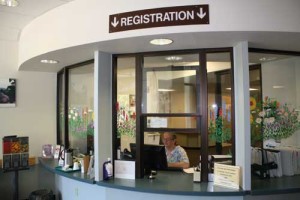 The first face you see when you enter the lobby for the Emergency Department and Acute Care and the last face you see when you are leaving, the Health Unit Coordinator (HUC) team member is a key patient contact that many may not know. These caring, observant, detail-oriented, multi-taskers are willing and able to ensure that the patients (“their patients”) and their families have their needs met. Due to the demands of the position, finding and training new team members is difficult and involves extensive training. Luckily, at Boundary Community Hospital, we are fortunate to have eight individuals that proudly represent the hospital in this capacity, many of whom have worked here for years.
The first face you see when you enter the lobby for the Emergency Department and Acute Care and the last face you see when you are leaving, the Health Unit Coordinator (HUC) team member is a key patient contact that many may not know. These caring, observant, detail-oriented, multi-taskers are willing and able to ensure that the patients (“their patients”) and their families have their needs met. Due to the demands of the position, finding and training new team members is difficult and involves extensive training. Luckily, at Boundary Community Hospital, we are fortunate to have eight individuals that proudly represent the hospital in this capacity, many of whom have worked here for years.
According to Ann Coughlin, HR Director: “This job takes a special skill and excellent interpersonal skills as they are dealing with family members and patients during stress-filled times.”
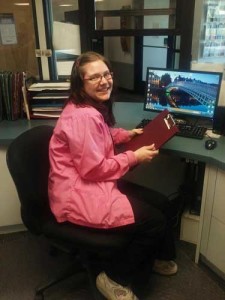 The Health Unit Coordinator’s responsibility is to perform clerical duties for both the emergency department and the acute care nursing stations, and they serve as a receptionist for all patients, visitors and persons requiring information and assistance. Sound like a typical office position? The reality is not so cut and dried. Many of the phone calls handled by the HUCs involve responding to emergency situations and making arrangements for transport via ambulance, fixed wing, or helicopter, while also preparing necessary transfer documents for the receiving facility. As many of our HUCs are also trained certified nursing assistants, you may also see them assisting in Code Blue situations by recording the events or assisting in any way that they can. They also assist with answering patient call lights in the hospital, as well as delivering meals to patients and assisting nursing staff with other patient needs.
The Health Unit Coordinator’s responsibility is to perform clerical duties for both the emergency department and the acute care nursing stations, and they serve as a receptionist for all patients, visitors and persons requiring information and assistance. Sound like a typical office position? The reality is not so cut and dried. Many of the phone calls handled by the HUCs involve responding to emergency situations and making arrangements for transport via ambulance, fixed wing, or helicopter, while also preparing necessary transfer documents for the receiving facility. As many of our HUCs are also trained certified nursing assistants, you may also see them assisting in Code Blue situations by recording the events or assisting in any way that they can. They also assist with answering patient call lights in the hospital, as well as delivering meals to patients and assisting nursing staff with other patient needs.
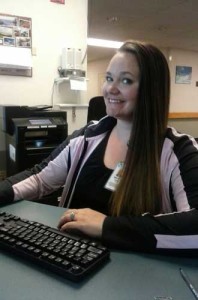 Tearful children being held in their mother’s arms checking in to see the emergency physician, the HUC needs to quickly assess the urgency of the situation and call for immediate assistance if appropriate. Once that assessment is complete, the HUC then needs to properly identify the patient, verify insurance information, get permission slips signed, and enter the necessary demographics to ensure accurate accountability and efficient healthcare processing. The HUC oftentimes travels to the patient bedside to complete the necessary paperwork so that the registration process does not impede the provision of the care the patient requires.
Tearful children being held in their mother’s arms checking in to see the emergency physician, the HUC needs to quickly assess the urgency of the situation and call for immediate assistance if appropriate. Once that assessment is complete, the HUC then needs to properly identify the patient, verify insurance information, get permission slips signed, and enter the necessary demographics to ensure accurate accountability and efficient healthcare processing. The HUC oftentimes travels to the patient bedside to complete the necessary paperwork so that the registration process does not impede the provision of the care the patient requires.
The same attention and care provided to the patient is also provided to family members, many of whom are distraught after following the ambulance here. Our HUCs swing into action providing comfort and information to the family members, and may also obtain information about the patient including medical history, lists of medications, and other vital information that can be passed on to the emergency room staff.
During your stay in the hospital, you will often see the HUCs following up on additional tests and therapy ordered. They also work closely with your insurance company to obtain proper authorizations to ensure that your stay is approved and they meet daily with the hospital utilization review team to make sure you are receiving the care you need. Like a traffic cop, the HUC makes sure things are flowing smoothly through all of the steps involved in your stay. The job doesn’t end there, once the patient departs, the HUC once again reviews the documentation to ensure that all of the medical record forms are complete and then they are scanned into the electronic record.
Lana Herzinger, HIM Director and supervisor of these HUCs, shared the following. “Truthfully, the HUCs would be better labeled with the title of ‘hub’, with many ‘spokes’ joining at their center, e.g. physicians, nursing staff, patient financial services, and medical records, and they are crucial to the smooth movement of the acute care and emergency department wheel. Everyone knows to go to their ‘hub’ to find the answers they need.”
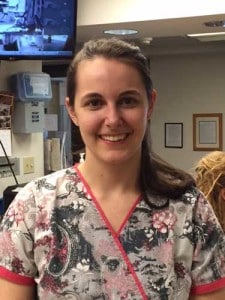
Boundary Community Hospital salutes the ED/Acute Care Health Unit Coordinator Team (Kim B., Leassa B., Anna R., Randi G., Anya K., Cory M., Jayme S., Melenie H.) and thanks them for their excellent service, attention to detail, thoroughness, and compassionate care they provide to the patients, employees, and visitors.

Is Doing Chores Your Workout?
/in Press ReleaseBy: Petra Timmermans, PT
Boundary Community Hospital Rehabilitation Services Manager
Many injuries can be prevented with preparation and attention. Here are some additional tips:
Pain-free movement is crucial to your quality of daily life, ability to earn a living, the pursuit of leisure activities, and much more; so please be careful when you begin your winter chores.
Physical Therapists can improve mobility and motion as well as long term pain management. Talk with your physician about all the ways a physical therapist can help.
TSE Childhood Injury Prevention Month
/in Press Release, Time Sensitive EmergencySeptember – National Childhood Injury Prevention Month
By – Stu Willis, MD & Gina Gallette, RN
Boundary Community Hospital Emergency Department
Your three-year-old child falls from the ladder as he mimics his dad changing a light bulb a few minutes ago…he’s unconscious and has a softball-size swelling on his forehead! Your six-year-old daughter slips and slices into her tummy while “playing mommy” cutting a zucchini…there’s a lot of blood and she’s barely breathing! What panic just the thought of these cause parents. What fret for friends and relatives. And then, “Where did I put the cell so I can call 9-1-1?”
According to the Centers for Disease Control and Prevention, 10 million children visit U.S. emergency departments each year due to an injury – that’s one visit for every six children…and tragically, over 10,000 are fatal. Injury is the leading cause of death and disability for U.S. children.
In the past 11 months, the Emergency Department of Boundary Community Hospital treated 287 persons under the age of 18 for injuries. Over 130 were fractures, dislocations, and sprains. Over 60 were injuries to the head and neck, more than 50 were deep cuts, along with a scattering of burns, bites, stings, and a few potential poison ingestions. The majority of these injuries were related to motor vehicle accidents, organized sports, or playground-type activities.
In 2012 the Center for Disease Control (CDC) launched the National Action Plan (NAP) for Child Injury Prevention. The goals of this NAP are first to raise awareness of childhood injuries; second, highlight preventive solutions; and finally, implement those solutions to decrease childhood injuries through community education and training.
Looking back over the last few decades, various child safety initiatives have made a difference…“child-proofing the home,” use of child safety seats and bike helmets, concussion guidelines for sports injuries, installing smoke alarms and pool fencing, to name a few. While childhood injuries have decreased, the NAP goal is for continuous improvement.
The staff of Boundary Community Hospital is dedicated to providing more than just treatment of injuries – we play an active and key role in community education in injury prevention.
A Few “Be Safe” Reminders:
And parents, keep in mind your children are much more likely to follow safety measures if you model them. As the old saying goes, “More is caught than taught” – your example is powerful.
###
Behind the Scenes – Laboratory
/in Behind the ScenesThe Truth is in the Details
The Laboratory Scientist
What is one of the fastest growing professions in the United States?
Clinical Laboratory Science professionals.
It has been estimated by the Bureau of Labor Statistics that 15,000
new Clinical Laboratory Science professionals are needed annually; fewer than 5,000 graduate each year!
Whether you call them Clinical Laboratory Scientists, Medical Technologists, or Medical Lab Scientists, the role of the individual doing clinical laboratory testing is crucial to the detection, diagnosis, and treatment of disease. Clinical Lab Scientists must be able to accurately perform and report all complex specialized laboratory analyses requiring advanced skills, technical expertise and broad use of independent judgement. They complete routine and “STAT” laboratory tests in chemistry, immunology, hematology, serology, immunohematology, urinalysis, microbiology
and coagulation.
Laboratory tests provide a virtual “snapshot” of a patient’s health status at any given time. It is estimated that 60 to 80 percent of physicians’ diagnoses are the product of a lab test; decisions regarding a patient’s diagnosis, treatment, hospital admission and discharge are influenced by laboratory test results.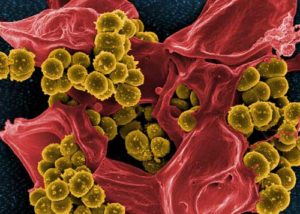
Here at Boundary Community Hospital we have our own full-service, Idaho-licensed, inspected and accredited Clinical Medical Laboratory that operates 24 hours a day, 7 days a week. Our highly-qualified, certified Medical Laboratory Scientists perform diagnostic laboratory testing looking for bacteria, parasites, and other microorganisms; analyzing the chemical content of fluids; matching blood for transfusions; and testing for drug levels in the blood that show how a patient is responding to treatment while utilizing state-of-the-art analyzers, all with computer integration and interlinked computer communications with other health care facilities and our reference lab.
State-of-the-art equipment in the hands of our skilled workforce is not the whole story in the Boundary Community Hospital Lab. As a medical laboratory in a rural community, we realize that each specimen and result affects our friends and neighbors’ lives. We are committed to keeping the community healthy and well-served.
In the near future, we will need to invest in new equipment or upgrades for existing machines. These updates are examples of our commitment to providing the best, most accurate tests in a timely manner. As always, Boundary Community Hospital is committed to providing accessible, high-quality, cost-effective services to everyone in our community.
Boundary Community Hospital salutes the team of Laboratory Scientists and Phlebotomists and thanks them for their excellent service, attention to detail, thoroughness, and compassionate care they provide to their patients.
Extended Care Facility Excellence in Caring – Again
/in Press ReleaseJuly 26, 2016
Bonners Ferry, ID – Boundary Community Hospital is proud to announce that their Extended Care Facility and Nursing Home has been recognized by the State of Idaho with their ninth L. Jean Schoonover Award for Excellence in Caring – the only nursing home in North Idaho to be so recognized. Recipients of the award must demonstrate a dedication and commitment to providing the highest quality of care to the residents they serve.
In addition, the Extended Care Facility completed their annual survey by the Idaho Department of Health and Welfare. The surveyors reported that the survey was 100% deficiency free. The Nutrition Services Department also had a 100% deficiency free report. These are excellent examples of the quality of care that our hospital and extended care facility employees are providing to the community, especially those that need long term and skilled nursing care.
The Extended Care Facility at Boundary Community Hospital is a licensed skilled nursing home with a physician on staff to supervise each resident’s care providing both long-term and rehabilitative or short-term residency. The highly-skilled staff understand and specialize in long term care, bringing a special nurturing atmosphere that can be felt every day throughout the facility.
An example – recent fishing outing to Smith Lake.
Rehab Department Recognized for Excellence
/in Press ReleaseBoundary Community Hospital Rehabilitation Department Receives the FOTO® Outcomes Excellence Award for Clinic Quality
Boundary Community Hospital’s Rehabilitation Department is proud to announce it has received the FOTO Outcomes Excellence Award for Orthopedic Physical Therapy from Focus On Therapeutic Outcomes, Inc. (FOTO®). The FOTO Outcomes Excellence Award honors a select group of Rehabilitation providers that exceed the national average for Functional (FS) change in FOTO’s database for four consecutive quarterly reporting periods.
To earn the Outcomes Excellence Award a provider must consistently achieve superior scores for patient improvement, treatment efficiency and patient satisfaction. Each Quarter FOTO produces benchmarked reports for its subscribers that are used to help the providers understand how their clinics compare to other providers. The providers use the reports to manage their clinics to provide the best patient care.
FOTO is an international outcomes database for medical rehabilitation providers that measures and reports provider treatment quality and efficiency. The FOTO database of over 11 million individual patient assessments provides risk-adjusted comparative benchmarked reports used to measure, predict, and compare outcome results. With a focus on treatment effectiveness, efficiency and patient satisfaction, the FOTO Outcomes data proves the quality of care provided by Boundary Community Hospital.
“It is wonderful to be recognized for our patient outcomes and satisfaction,” says Rehabilitation Services Manager, Petra Timmermans, PT. “Our Rehab Team focuses on treatment and therapies that ensure our patients regain mobility and attain the highest level of independence.” The Boundary Community Hospital Rehabilitation Department offers three therapies: Physical, Occupational and Speech. Therapists work with inpatient hospital and swing bed patients as well as outpatients by appointment. To make an appointment or visit the facility, call (208) 267-3141 ext 4276.
“Boundary Community Hospital is part of a select group that demonstrates their commitment to quality care by agreeing to compare their performance data to other progressive organizations across the country. The growing database includes outcomes from over 3,400 outpatient hospitals and private practice clinics, and over 15,000 clinicians participate.” said Al Amato, FOTO President.
The Outstanding Rehabilitation Team at Boundary Community Hospital
Standing, from left to right: Sue Lombard, Occupational Therapist; Didier Balcaen, Physical Therapist; Rob Aronow, Speech Therapist; Katie Blumenauer, Admin Assistant/Scheduler Sitting, from left to right: Tammy Edge, Physical Therapist Assistant; Petra Timmermans, Physical Therapist and Department Manager; and Jeff Petersen, Physical Therapist
Stuffed Critters Donated to Boundary Community Hospital
/in Foundation, Press ReleaseWanda Wilkerson (left) and Sean McCoy (center) from the hospital Emergency Department accept the stuffed critters from Fry Healthcare Foundation President, Carol Julian (right).
The first set of stuffed critters donated to Boundary Community Hospital through the generosity of the Fry Healthcare Foundation Veryl Lindsay Memorial Fund arrived in the Emergency Department and Extended Care Facility. Wanda Wilkerson (left) and Sean McCoy (center) from the hospital Emergency Department accept the stuffed critters from Fry Healthcare Foundation President, Carol Julian (right).
“Thank you to everyone who donated in memory of Veryl Lindsay” says Carol Julian, President of Fry Healthcare Foundation. “Donations like this, which bring comfort to those in need, show how much our community cares for our friends and neighbors. We appreciate the help from Sugar Plum Floral in finding these lovable stuffed critters for the hospital.”
Established by the Lindsay family through the Fry Healthcare Foundation in memory of Veryl Lindsay, who worked as a Registered Nurse at Boundary Community Hospital from 1954-1986, the donated funds are used to purchase stuffed animals for Emergency Department patients or family members, children hospitalized for care, or dementia patients who need comfort. If you would like to donate in memory Veryl Lindsay, send your check to Fry Healthcare Foundation, 6640 Kaniksu Street, Bonners Ferry, ID 83805.
Behind the Scenes – Radiologic Technologist
/in Behind the ScenesSeeing Inside You – The Radiologic Technologist
Boundary Community Hospital has a reputation for quality and excellence in providing superb diagnostic imaging, thoughtful patient care and professional radiological interpretations. It is the highly-skilled, well-trained team of Radiologic Technologists that bring their expertise and patient-centric focus to ensure that Boundary County benefits from this major investment at the hospital. Our caring team continues to upgrade their certifications so that as new equipment is purchased, their skills stay cutting edge and they maintain the highest level of care.
Digital Radiography is a form of X-ray imaging, where digital X-ray sensors are used instead of traditional photographic film. Advantages include time efficiency through bypassing chemical processing and the ability to digitally transfer and enhance images. Also, less radiation can be used to produce an image of similar contrast to conventional radiography.
Computerized Tomography (CT) combines a specialized x-ray machine and a computer to produce images one slice at a time, like a spiral ham. The scan, completed while you lie on a table, is performed by a Radiologic Technologist from an adjoining room who you will communicate with through a speaker system. The procedure is painless and usually takes about thirty minutes. Once your scan is finished, the Technologist presents the cross-sectional, multi-dimensional images to the Radiologist for interpretation. Our Technologists are busy studying to get their certifications so that they are ready for the new 64 Slice CT Scanner coming this summer. This new technology CT Scanner will provide better, finer images for more accurate diagnoses.
Board-certified Specialists provide expertise in special equipment used in several diagnostic situations.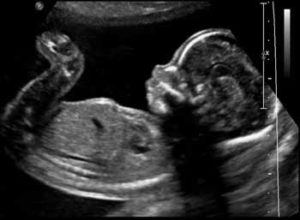
Ultrasound – Board-certified by the American Registry of Diagnostic Medical Sonographers with Certifications in OB/GYN, Abdominal, Breast and Vascular Imaging, the experienced Registered Diagnostic Medical Sonographer, or Ultrasonographer, manages the state-of-the-art ultrasound equipment used to examine the fetus during pregnancy, visualize certain gynecological functions in non-pregnant women, reveal information about tumors and cysts, evaluate the gallbladder and related organs, and for noninvasive evaluation of vascular disease.
Mammography – Board-certified by the American Registry of Radiologic Technologists with advanced certification in Mammography, our experienced Radiologic Technologist performs mammograms by appointment only. A mammogram is an x-ray of the breast. A diagnostic mammogram is used to diagnose breast disease in women, and occasionally men, who have breast symptoms or an abnormal result on a screening mammogram. Screening mammograms are used to look for breast disease in women who are asymptomatic; that is, those who appear to have no breast problems.
MRI – When the Mobile MRI rolls into place on Thursdays at the hospital, it comes with a Radiologic Technologist that specializes in magnetic resonance imaging. This non-invasive, revolutionary process enables doctors to “see” right through bone as well as evaluate soft tissue inside your body, without surgery and without the radiation that is used in x-rays and CT scans.
At Boundary Community Hospital, our goal is to provide the community with timely modern radiology services that are second to none. You can expect fast and friendly service from the moment you schedule your exam to the moment your physician receives the results. Your health is important to you, and so is your time.
Boundary Community Hospital salutes the Diagnostic Imaging team of Radiologic Technologists and thanks them for their excellent service, attention to detail, thoroughness, and compassionate care they provide to their patients.
A Tradition of Caring for the Community
/in Press ReleaseMay 15, 2016
By: Lauren Kuczka
Boundary Community Hospital has been celebrating National Hospital Week with its annual Health Fair and Fun Run for decades and this year was no exception. Beautiful weather contributed to the fun, when 200 runners and walkers of all ages took to the 3K, 5K and 10K courses across the North side of Bonners Ferry.
The Hospital Auxiliary was drawing certificate winners every 10 minutes and many people continued to buy tickets as the event progressed. The Great Golf Ball Drop was kicked off by the Fry Healthcare Foundation. Buy a lucky numbered golf ball entry and win a 50” Smart TV. The winning entry will be determined on June 10th at 6:30 pm at the 8th Annual Golf Tournament to benefit the Hospital.
Fun Run T-Shirts are still available for $10.00 each. Pick one up at the Community Relations Office while they last. Proceeds go to support the Fun Run and Health Fair.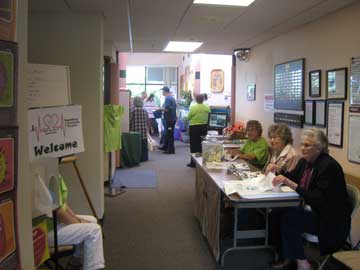
Thank you to the hospital staff and family members who volunteered to help at the fair and to all of the wonderful local vendors: Luther Park at Sandpoint, Panhandle Health District, Sandpoint Women’s Health, Bonner Partners in Care Clinic (BPICC), Auburn Crest Hospice, Take Shape For Life, Alzheimer’s Association, University of Idaho Extension Boundary County, Sunset Home Assisted Living, Bonners Ferry Women’s Cancer Education & Support Group, Inc., Sandpoint Community Resource Center, North Idaho College Bonners Ferry, Department of Insurance – SHIBA, Senior Medicare Patrol, Boundary County Restorium, Advanced Care Northwest LLC, Bonner General Home Health and Hospice, Overeaters Anonymous, Community Coalition of Families, Art of Redirection Counseling, State Farm Insurance, Grand Canyon University, Kaniksu Health Services, Playworks Counseling Center, Boundary County Victim Services, Cancer Fighters, Medicine Man Pharmacy, Bonners Ferry Yoga, and Mobile Hearing Care. Outdoor exhibitors included Bonners Ferry Fire Department, Boundary Ambulance Service, Life Flight Network Helicopter, BoCo Backpacks, Medical Support Reserve Corps of North Idaho, Far North Outfitters, Grow! Gardeners for Regional Organic Wellbeing and Eden Landscape and Design.
At Boundary Community Hospital we understand the unique healthcare needs of our rural neighborhood. We are committed to providing accessible, high-quality, cost-effective treatment to everyone in our community. This means delivering comprehensive services from acute critical care to rehabilitation to transitional care as well as community outreach, wellness and education programs. We continue to upgrade technology, improve patient care and build collaborative partnerships with other healthcare providers in the region. We are proud to provide the vital health services you and your family demand, delivered with professionalism and compassion – right here at home.
Photo Credit: Kim Nelson, Boundary Community Hospital
Behind the Scenes – Health Unit Coordinator
/in Behind the ScenesHealth Unit Coordinator in Acute Care
According to Ann Coughlin, HR Director: “This job takes a special skill and excellent interpersonal skills as they are dealing with family members and patients during stress-filled times.”
The same attention and care provided to the patient is also provided to family members, many of whom are distraught after following the ambulance here. Our HUCs swing into action providing comfort and information to the family members, and may also obtain information about the patient including medical history, lists of medications, and other vital information that can be passed on to the emergency room staff.
During your stay in the hospital, you will often see the HUCs following up on additional tests and therapy ordered. They also work closely with your insurance company to obtain proper authorizations to ensure that your stay is approved and they meet daily with the hospital utilization review team to make sure you are receiving the care you need. Like a traffic cop, the HUC makes sure things are flowing smoothly through all of the steps involved in your stay. The job doesn’t end there, once the patient departs, the HUC once again reviews the documentation to ensure that all of the medical record forms are complete and then they are scanned into the electronic record.
Lana Herzinger, HIM Director and supervisor of these HUCs, shared the following. “Truthfully, the HUCs would be better labeled with the title of ‘hub’, with many ‘spokes’ joining at their center, e.g. physicians, nursing staff, patient financial services, and medical records, and they are crucial to the smooth movement of the acute care and emergency department wheel. Everyone knows to go to their ‘hub’ to find the answers they need.”
Boundary Community Hospital salutes the ED/Acute Care Health Unit Coordinator Team (Kim B., Leassa B., Anna R., Randi G., Anya K., Cory M., Jayme S., Melenie H.) and thanks them for their excellent service, attention to detail, thoroughness, and compassionate care they provide to the patients, employees, and visitors.
Mobile Ultrasound – Newest Tool in the Emergency Department
/in Foundation, Press ReleaseDr. Stu Willis, Emergency Department Director, demonstrates the new Mobile Ultrasound purchased by Fry Healthcare Foundation for the Emergency Department at Boundary Community Hospital.
Thank you to the Fry Healthcare Foundation and their Festival of Trees for raising the funds to add a Mobile Ultrasound Machine to the Emergency Department at Boundary Community Hospital.
“This is a welcome addition to our Emergency Department toolbox,” says Hospital CEO Craig Johnson. “As a Critical Access Hospital, we need to stay current on technology that will save the lives of the people who depend on us to provide those services.”
According to Dr. Stu Willis, Emergency Department Director, “Ultrasound devices have shrunk to the point where they are now handheld and can be used in the emergency department for easier triage, faster interventions for acute events, and better monitoring. In time sensitive emergencies you need tools like this that can be brought to the patient for faster diagnoses. For example, we can immediately see if a lung has collapsed and address the situation quickly and efficiently. Our friends and neighbors in Boundary County will benefit from having this state-of-the-art equipment available, if needed.”
Ultrasound (or “Sonography”) is a procedure that uses high-frequency sound waves to show what is inside your body. Similar to sonar used in ocean research, the ultrasound emits sound waves which pass through the body, which is 90% water. The sound waves bounce off tissues and organs and an echo is sent back to high-speed computers which use the echo to create an image. This results in a very detailed examination, which aids the physician in a diagnosis. In addition, some information is displayed using color Doppler images and includes accurate blood flow measurements. This is called color-flow Doppler. An ultrasound examination is fast, with very little discomfort. No radiation or x-rays are necessary.
“The support and generosity of the community for the Fry Healthcare Foundation directly impacts the high quality of care provided by Boundary Community Hospital,” according to Fry Healthcare President, Carol Julian. “Thank you to everyone who helped make this year’s Festival of Trees such a success and giving us the opportunity to provide the hospital with this vital piece of equipment. The 2015 Festival of Trees raised over $40,000 which we are using to purchase the Mobile Ultrasound and other equipment for the Emergency and Rehabilitation Departments.”